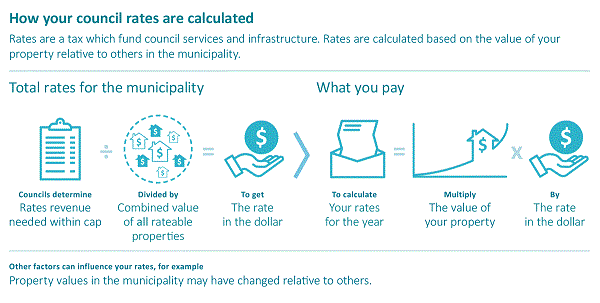Rates are an important part of your council's ability to fund and deliver essential community infrastructure and services.
The rates your council collects are a form of property tax. The value of each property is used as the basis for calculating what each property owner will pay.
How are your rates calculated?
When deciding how much it needs to raise in general rates, your council considers community needs in relation to its available income for the coming year. This is done when your council is preparing its annual budget.
The total amount of money to be raised in general rates is divided by the total value of all rateable properties in your area. The resulting figure is called the 'rate in the dollar'. The council will then determine the amount to be paid in rates by applying a 'rate in the dollar' to the assessed value of each property.

Frequently asked questions
How is a 'rate in the dollar' calculated?
For a council using only a general rate (some use special rates for particular projects or needs), the rate in the dollar is calculated as in the following example:
- A council plans to raise total rate revenue of $10 million.
- The total Capital Improved Value of all rateable properties in the municipality is $2.38 billion (Capital Improved Value means the value of the land, the building and any capital improvements made to the property)
- The rate in the dollar is calculated by dividing $10 million by $2.38 billion to obtain a rate in the dollar of 0.42 cents.
How are a property's rates calculated?
The formula for calculating the rates for an individual property is the property valuation multiplied by the rate in the dollar set by the council.
For example, if the Capital Improved Value of a property is $250,000 and the council rate in the dollar is set at 0.42 cents, the rate bill would be $1,050 ($250,000 x 0.0042).
Your rate notice will provide specific details on how your rates are calculated.
How do property valuations affect rates
Councils break up the total rates revenue they wish to collect by distributing the burden across all rateable properties, depending on each property’s value in relation to all other rateable property values in the municipality.
Property values are calculated every two years. 2016 was a revaluation year.
What are differential rates?
Differential rates are where councils set different rates in the dollar for different categories of rateable land. For example, farm land, various categories of residential property or commercial/industrial properties will each pay a higher or lower rate in the dollar.
What other rates and charges apply?
Many councils impose a service rate or annual service charge for certain purposes such as the collection and disposal of waste.
Councils may also levy a municipal charge, which is a flat charge that can offset some of the council's administrative costs. The total amount raised from the municipal charge cannot be more than 20 per cent of the total raised from the combination of municipal charge and general rates.
Special rates or charges can be applied to particular works or services (such as footpaths, roads, kerbs and channels, or drains) and for providing services like promotion, marketing or economic development.
A property-based fire services levy is collected with council rates. The Fire Services Property Levy funds vital life-saving equipment, firefighters, staff and volunteers, training, infrastructure and community education. All revenue collected through the Fire Services Property Levy goes to supporting the state's fire services.
Why do we need rates?
Victoria's 79 local government areas and councils provide essential services to all Victorians and are an important part of our government structure.
The services provided vary greatly from council to council, but include:
- waste collection
- local road maintenance and construction
- maternal and child care, kindergartens, and services for youth and older citizens
- public libraries
- public sporting and recreation facilities such as swimming pools, ovals, parks, gardens, playground, public halls and arts centres
- town planning and related services
- traffic management and animal control services
- economic development activity, tourism, community arts projects and festivals.
Rates are one of the main ways that councils get the money they need to deliver essential services and infrastructure to the Victorian community.
Council rates are a tax. Property values are used as the basis for calculating how much each property owner pays in rates.
All councils raise money through rates to cover part of the cost of providing a range of services and infrastructure projects. Depending on the amount a council may need to raise through rates, and the value of the rate base, different municipalities will strike different rates in the dollar. As a result, properties of similar values can be levied different rates from council to council.
The proportion of council's income that comes from rates varies. Other income comes from user-pays fees (e.g. swimming pool admissions), service charges (e.g. planning fees), animal registration, parking fees, fines, and grants from Victorian and Federal Governments.